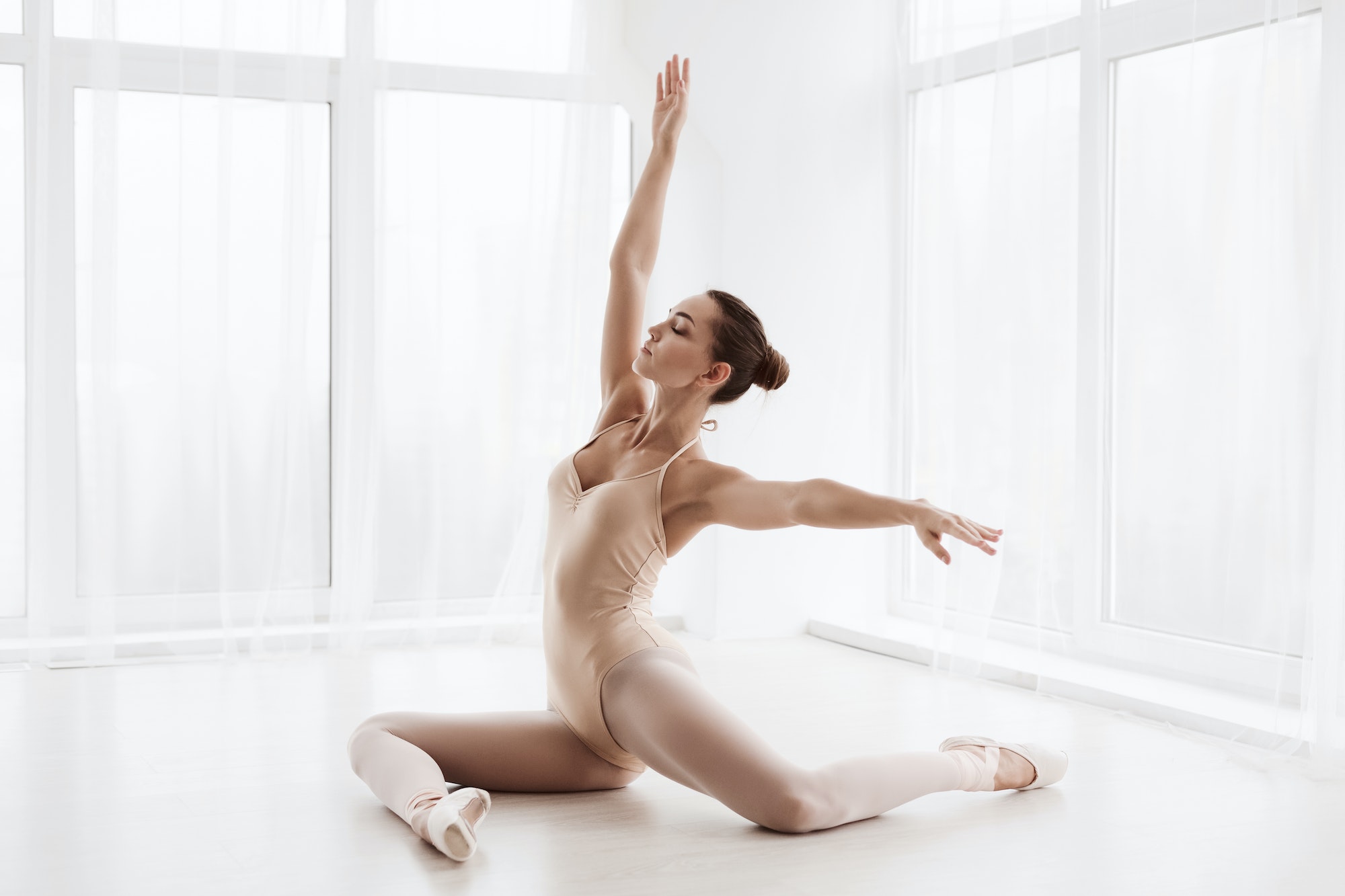Ballet dancers make it look effortless as they glide across the stage, but classical ballet requires immense core strength, balance, flexibility, and endurance. That’s why more people are turning to ballet fitness for an graceful yet challenging workout.
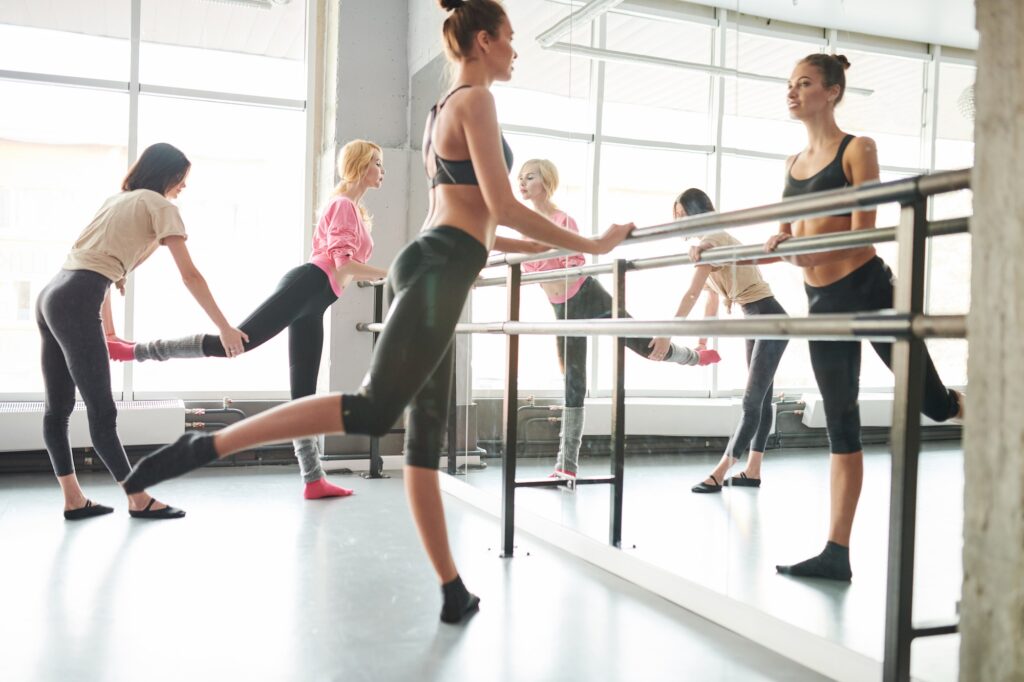
One of the first things I did when we finally had space for a home gym was install a ballet barre. Ok, it’s not a TRUE ballet barre. It’s a 1″ dowel rod, but it is an affordable ballet barre. I find it’s the exercise that I stick with. I do wear ballet shoes, but I don’t (at least not all the time) wear a leotard and tights. You don’t need special clothing to do a ballet workout. A pair of socks will work.
Ballet fitness is my favorite way to incorporate a fun workout into my day. It works muscles you didn’t know you had and has the added bonus of making you feel amazing. Ballet fitness can be dance, barre workouts, or any other type of ballet fitness that incorporates ballet movement.
The All-Over Body Workout
Unlike many other dance styles that focus on the lower body, ballet movements engage the entire body from head to toe. The constantly engaged core required in ballet develops abdominal strength. The variety of arm movements tones the upper body. Maintaining proper turnout works the inner thighs and glutes. Moving through demi and full pliés also strengthens and sculpts the legs and butt.
This full-body engagement means ballet provides an effective muscle-strengthening workout comparable to activities like weight-lifting but with added benefits of mobility and coordination. Dancing complex ballet choreography for even just 30 minutes can burn over 200 calories! With regular practice, you’ll notice improved muscle tone, especially in your core, arms, thighs and derrière.
Plus, proper ballet posture requires keeping the shoulders back and down, chest lifted, and neck elongated, which not only improves appearance but also strengthens the upper back.
Ballet Fitness Sculpts Long, Lean Muscles
Unlike the bulky muscles you get from heavy weight-lifting, ballet develops longer, leaner muscles. The small precise movements target smaller supporting muscle groups that get overlooked in many workouts. Developing these areas creates the signature long, toned limbs of dancers.
Ballet’s sustained holds, like balancing in arabesque, build muscle endurance. The fluid yet controlled motions create supple strength without bulk that translates into gorgeous body definition. Doing barre exercises that focus on high rep counts with lighter weights sculpts this slim, graceful physique.
Ballet Fitness Increases Flexibility
Ballet movements demand considerable flexibility to extend the legs and spine, especially for attaining those signature deep pliés and seamless backbends. The hamstrings, hip flexors, and spine get an intense stretch workout during a ballet class. This limbers the body so you can move through poses with greater ease and range of motion.
Regular ballet training delivers noticeable improvement in overall flexibility and mobility. Dancers can serve as inspiration for how remarkably agile the body can become. Even beginners notice a difference in how much farther they can comfortably bend, twist, and reach within just weeks.
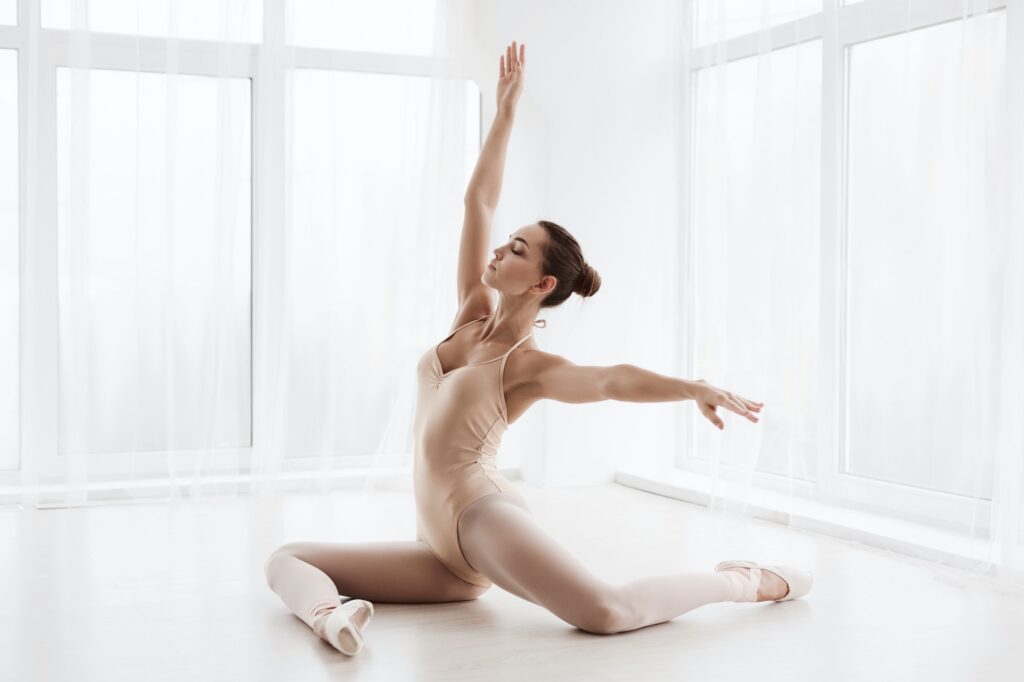
Better Balance and Posture with Ballet Fitness
Proper ballet requires kept abs, activated back muscles, centered alignment, and concentration on balance. Holding positions like arabesque and pirouettes trains balance even when only on one foot! The focus on posture and body alignment translates into standing and sitting taller. Even non-dancers benefit from improved core stability, coordination, and overall poise.
Injury Prevention
The control and precision crucial for ballet help develop body awareness that prevents injury. The care taken to move within proper alignment while engaging appropriate muscles protects joints like the knees and ankles. Increased flexibility also reduces muscle strains. Strengthening muscles surrounding the spine helps prevent back pain. For athletes, ballet’s balanced muscle development can complement intense sports training and reduce risk of repetitive strain injuries.
Mental Benefits
Beyond the impressive physical results, ballet fitness also boosts focus, spatial awareness, memory, creativity, and confidence. Learning choreography challenges the mind to recall intricate steps, tempo, and formations. Ballet requires tuning out distractions and focusing mentally and physically. Dancers report an increased mindfulness similar to yoga and meditation. Expressing yourself through beautiful dance can also lower stress and anxiety.
Accessible Yet Challenging Workout
One of the appeals of ballet fitness is that it can be done by anyone at any age or fitness level. Beginner classes start slow with the basics like stance and simple barre exercises. You don’t need any special equipment besides soft ballet slippers and comfortable workout clothes. Yet as you advance, there are always new skills to master, from holding your balance longer to completing fouetté turns. Ballet offers continual challenges so you never get bored but also see measurable progress to stay motivated.
Watch and Learn Ballet At Home
If you want to explore ballet fitness in the comfort of your home, check out these online resources:
Online Tutorials on YouTube
For a basic intro class, check out Kathryn Morgan’s Beginner Ballet Class. Ballet dancer Kirsten Russell also has Beginner Ballet Tutorials focusing on positions and barre exercises. The Royal Academy of Dance channel has a complete playlist of Silver Swans ballet classes tailored for seniors. There are many other YouTube channels that incorporate ballet fitness, have ballet or barre classes, or have workouts for ballerinas.
Digital Streaming Services
Take structured online classes through ballet-focused platforms like My Ballet Coach and Ballerina Project Live with a monthly membership. Apps like Peloton also stream beginner through advanced-level ballet classes. Or try the Ballet Class Workout program on obé fitness.
Fitness Subscriptions
Major workout subscription services like Nike Training Club, 305 Fitness, and Daily Burn have ballet inspired programs. Try a Blend variation on Alo Moves that mixes Pilates and ballet for a full body burn.
Local Adult Classes
Look for “adult ballet” classes offered at local dance studios. Many have weekend or evening schedules perfect for busy professionals. Absolute Beginner classes focus on ballet foundations at a comfortable pace.
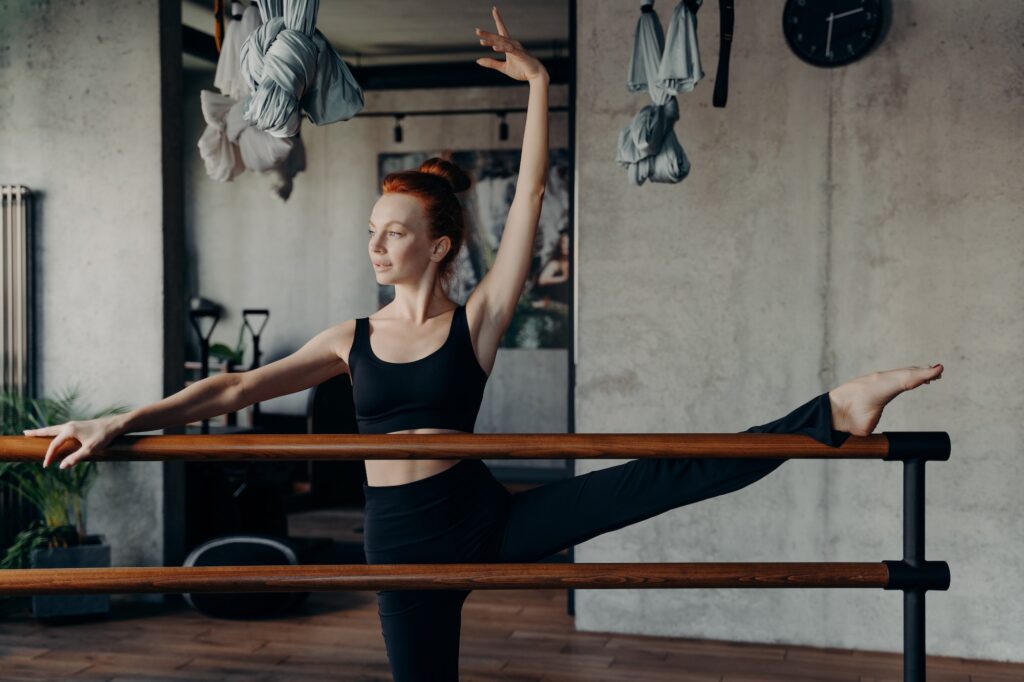
Instructional DVDs/Books
Check your local library or retail sites for instructional ballet DVDs you can do at home. Popular titles include Dancing with the Stars instructor Kym Johnson’s Ballet Body Workout and Ballerina Bun Workout. Pick up used ballet manuals like Adult Ballet: A Class for Older Dancers.
Live-Stream Ballet Performances
To add inspiration, watch free recordings of professional ballet performances online from world class dance companies like The Royal Ballet, Bolshoi Ballet, and American Ballet Theatre.
The accessibility of top-notch ballet instruction online makes it easy to give this graceful but powerful workout a try. The combination of physical rigor, mental focus, and artistic expression delivers full mind and body benefits that will leave you feeling poised and strong. So embrace your inner ballerina – with consistent practice you’ll be amazed at what your body can create and the new passion for movement you’ll find. Now it’s time to get those ballet slippers on and head to the barre!
The Grace and Strength of Ballet Fitness
Ballet dancers make it look effortless as they glide across the stage, but classical ballet requires immense core strength, balance, flexibility, and endurance. That’s why more people are turning to ballet for an graceful yet challenging workout. This article explores the many benefits of ballet for fitness and provides tips on where you can start ballet training from home.
The All-Over Body Workout
Unlike many other dance styles that focus on the lower body, ballet movements engage the entire body from head to toe. The constant engaged core required in ballet develops abdominal strength. The variety of arm movements tones the upper body. Maintaining proper turnout works the inner thighs and glutes. Moving through demi and full pliés also strengthens and sculpts the legs and butt.
This full body engagement means ballet provides an effective muscle-strengthening workout comparable to activities like weight-lifting but with added benefits of mobility and coordination. Dancing complex ballet choreography for even just 30 minutes can burn over 200 calories! With regular practice, you’ll notice improved muscle tone especially in your core, arms, thighs and derrière.
Plus proper ballet posture requires keeping the shoulders back and down, chest lifted, and neck elongated which not only improves appearance but also strengthens the upper back.
Sculpts Long, Lean Muscles
Unlike the bulky muscles you get from heavy weight-lifting, ballet develops longer, leaner muscles. The small precise movements target smaller supporting muscle groups that get overlooked in many workouts. Developing these areas creates the signature long, toned limbs of dancers.
Ballet’s sustained holds, like balancing in arabesque, build muscle endurance. The fluid yet controlled motions create supple strength without bulk that translates into gorgeous body definition. Doing barre exercises that focus on high rep counts with lighter weights sculpts this slim, graceful physique.
Increases Flexibility
Ballet movements demand considerable flexibility to extend the legs and spine, especially for attaining those signature deep pliés and seamless backbends. The hamstrings, hip flexors, and spine get an intense stretch workout during a ballet class. This limbers the body so you can move through poses with greater ease and range of motion.
Regular ballet training delivers noticeable improvement in overall flexibility and mobility. Dancers can serve as inspiration for how remarkably agile the body can become. Even beginners notice a difference in how much farther they can comfortably bend, twist, and reach within just weeks.
Better Balance and Posture
Proper ballet requires kept abs, activated back muscles, centered alignment, and concentration on balance. Holding positions like arabesque and pirouettes trains balance even when only on one foot! The focus on posture and body alignment translates into standing and sitting taller. Even non-dancers benefit from improved core stability, coordination, and overall poise.
Injury Prevention
The control and precision crucial for ballet helps develop body awareness that prevents injury. The care taken to move within proper alignment while engaging appropriate muscles protects joints like the knees and ankles. Increased flexibility also reduces muscle strains. Strengthening muscles surrounding the spine helps prevent back pain. For athletes, ballet’s balanced muscle development can complement intense sports training and reduce risk of repetitive strain injuries.
Mental Benefits
Beyond the impressive physical results, ballet also boosts focus, spatial awareness, memory, creativity, and confidence. Learning choreography challenges the mind to recall intricate steps, tempo, and formations. Ballet requires tuning out distractions and focusing mentally and physically. Dancers report an increased mindfulness similar to yoga and meditation. Expressing yourself through beautiful dance can also lower stress and anxiety.
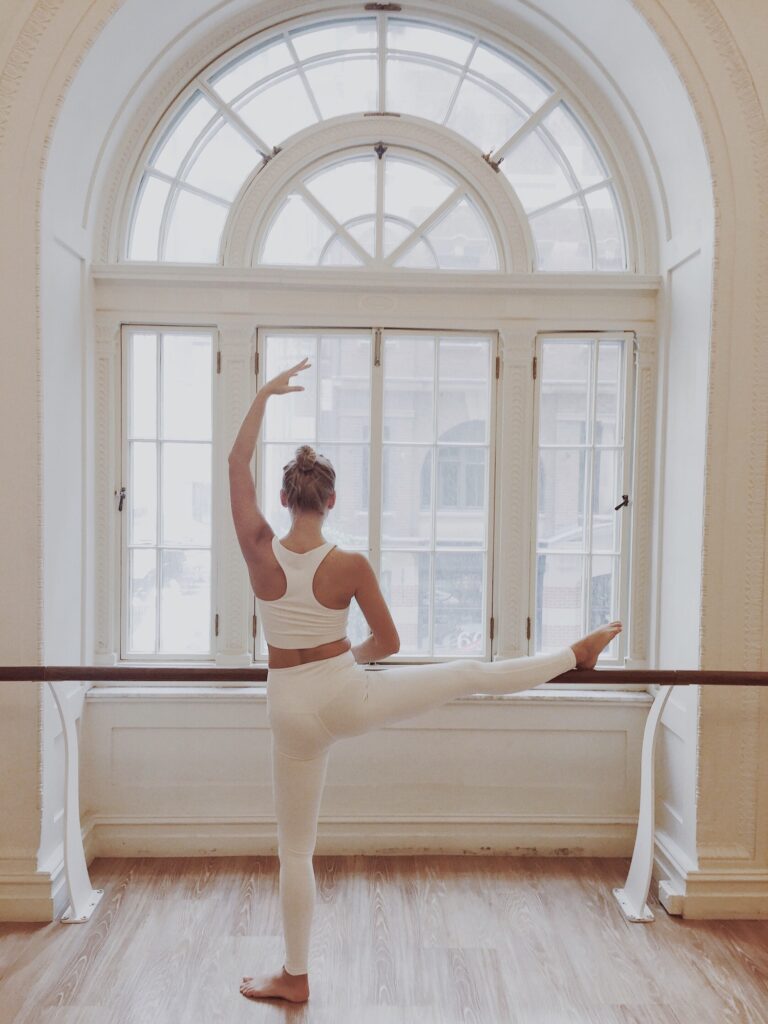
Accessible Yet Challenging Workout
One of the appeals of ballet for exercise is that it can be done by anyone at any age or fitness level. Beginner classes start slow with the basics like stance and simple barre exercises. You don’t need any special equipment besides soft ballet slippers and comfortable workout clothes. Yet as you advance, there are always new skills to master from holding your balance longer to completing fouetté turns. Ballet offers continual challenges so you never get bored but also sees measurable progress to stay motivated.
Watch and Learn Ballet At Home
If you want to explore ballet fitness in the comfort of your home, check out these online resources:
Online Tutorials on YouTube
For a basic intro class, check out Kathryn Morgan’s Beginner Ballet Class. Ballet dancer Kirsten Russell also has Beginner Ballet Tutorials focusing on positions and barre exercises. The Royal Academy of Dance channel has a complete playlist of Silver Swans ballet classes tailored for seniors.
Digital Streaming Services
Take structured online classes through ballet-focused platforms like My Ballet Coach and Ballerina Project Live with a monthly membership. Apps like Peloton also stream beginner through advanced level ballet classes. Or try the Ballet Class Workout program on obé fitness.
Fitness Subscriptions
Major workout subscription services like Nike Training Club, 305 Fitness, and Daily Burn have ballet inspired programs. Try a Blend variation on Alo Moves that mixes Pilates and ballet for a full body burn.
Local Adult Classes
Look for “adult ballet” classes offered at local dance studios. Many have weekend or evening schedules perfect for busy professionals. Absolute Beginner classes focus on ballet foundations at a comfortable pace.
Instructional DVDs/Books
Check your local library or retail sites for instructional ballet DVDs you can do at home. Popular titles include Dancing with the Stars instructor Kym Johnson’s Ballet Body Workout and Ballerina Bun Workout. Pick up used ballet manuals like Adult Ballet: A Class for Older Dancers.
Live-Stream Ballet Performances
To add inspiration, watch free recordings of professional ballet performances online from world class dance companies like The Royal Ballet, Bolshoi Ballet, and American Ballet Theatre.
The accessibility of top-notch ballet instruction online makes it easy to give this graceful but powerful workout a try. The combination of physical rigor, mental focus, and artistic expression delivers full mind and body benefits that will leave you feeling poised and strong. So embrace your inner ballerina – with consistent practice you’ll be amazed at what your body can create and the new passion for movement you’ll find. Now it’s time to get those ballet slippers on and head to the barre!
The Grace and Strength of Ballet Fitness
Ballet dancers make it look effortless as they glide across the stage, but classical ballet requires immense core strength, balance, flexibility, and endurance. That’s why more people are turning to ballet for an graceful yet challenging workout. This article explores the many benefits of ballet for fitness and provides tips on where you can start ballet training from home.
The All-Over Body Workout
Unlike many other dance styles that focus on the lower body, ballet movements engage the entire body from head to toe. The constant engaged core required in ballet develops abdominal strength. The variety of arm movements tones the upper body. Maintaining proper turnout works the inner thighs and glutes. Moving through demi and full pliés also strengthens and sculpts the legs and butt.
This full body engagement means ballet provides an effective muscle-strengthening workout comparable to activities like weight-lifting but with added benefits of mobility and coordination. Dancing complex ballet choreography for even just 30 minutes can burn over 200 calories! With regular practice, you’ll notice improved muscle tone especially in your core, arms, thighs and derrière.
Plus proper ballet posture requires keeping the shoulders back and down, chest lifted, and neck elongated which not only improves appearance but also strengthens the upper back.
Sculpts Long, Lean Muscles
Unlike the bulky muscles you get from heavy weight-lifting, ballet develops longer, leaner muscles. The small precise movements target smaller supporting muscle groups that get overlooked in many workouts. Developing these areas creates the signature long, toned limbs of dancers.
Ballet’s sustained holds, like balancing in arabesque, build muscle endurance. The fluid yet controlled motions create supple strength without bulk that translates into gorgeous body definition. Doing barre exercises that focus on high rep counts with lighter weights sculpts this slim, graceful physique.
Increases Flexibility
Ballet movements demand considerable flexibility to extend the legs and spine, especially for attaining those signature deep pliés and seamless backbends. The hamstrings, hip flexors, and spine get an intense stretch workout during a ballet class. This limbers the body so you can move through poses with greater ease and range of motion.
Regular ballet training delivers noticeable improvement in overall flexibility and mobility. Dancers can serve as inspiration for how remarkably agile the body can become. Even beginners notice a difference in how much farther they can comfortably bend, twist, and reach within just weeks.
Better Balance and Posture
Proper ballet requires kept abs, activated back muscles, centered alignment, and concentration on balance. Holding positions like arabesque and pirouettes trains balance even when on both feet! The focus on posture and body alignment translates into standing and sitting taller. Even non-dancers benefit from improved core stability, coordination, and overall poise.
Injury Prevention
The control and precision crucial for ballet helps develop body awareness that prevents injury. The care taken to move within proper alignment while engaging appropriate muscles protects joints like the knees and ankles. Increased flexibility also reduces muscle strains. Strengthening muscles surrounding the spine helps prevent back pain. For athletes, ballet’s balanced muscle development can complement intense sports training and reduce risk of repetitive strain injuries.
It is not advisable to dance en pointe without professional supervision.
Mental Benefits
Beyond the impressive physical results, ballet also boosts focus, spatial awareness, memory, creativity, and confidence. Learning choreography challenges the mind to recall intricate steps, tempo, and formations. Ballet requires tuning out distractions and focusing mentally and physically. Dancers report an increased mindfulness similar to yoga and meditation. Expressing yourself through beautiful dance can also lower stress and anxiety.
Accessible Yet Challenging Workout
One of the appeals of ballet for exercise is that it can be done by anyone at any age or fitness level. Beginner classes start slow with the basics like stance and simple barre exercises. You don’t need any special equipment besides soft ballet slippers and comfortable workout clothes. Yet as you advance, there are always new skills to master from holding your balance longer to completing fouetté turns. Ballet offers continual challenges so you never get bored but also sees measurable progress to stay motivated.
Watch and Learn Ballet At Home
If you want to explore ballet fitness in the comfort of your home, check out these online resources:
Online Tutorials on YouTube
For a basic intro class, check out Kathryn Morgan’s Beginner Ballet Class. Ballet dancer Kirsten Russell also has Beginner Ballet Tutorials focusing on positions and barre exercises. The Royal Academy of Dance channel has a complete playlist of Silver Swans ballet classes tailored for seniors.
Digital Streaming Services
Take structured online classes through ballet-focused platforms like My Ballet Coach and Ballerina Project Live with a monthly membership. Apps like Peloton also stream beginner through advanced level ballet classes. Or try the Ballet Class Workout program on obé fitness.
Fitness Subscriptions
Major workout subscription services like Nike Training Club, 305 Fitness, and Daily Burn have ballet inspired programs. Try a Blend variation on Alo Moves that mixes Pilates and ballet for a full body burn.
Local Adult Classes
Look for “adult ballet” classes offered at local dance studios. Many have weekend or evening schedules perfect for busy professionals. Absolute Beginner classes focus on ballet foundations at a comfortable pace.
Instructional DVDs/Books
Check your local library or retail sites for instructional ballet DVDs you can do at home. Popular titles include Dancing with the Stars instructor Kym Johnson’s Ballet Body Workout and Ballerina Bun Workout. Pick up used ballet manuals like Adult Ballet: A Class for Older Dancers.
Live-Stream Ballet Performances
To add inspiration, watch free recordings of professional ballet performances online from world-class dance companies like The Royal Ballet, Bolshoi Ballet, and American Ballet Theatre.
The accessibility of top-notch ballet instruction online makes it easy to give this graceful but powerful workout a try. The combination of physical rigor, mental focus, and artistic expression delivers full mind and body benefits that will leave you feeling poised and strong. So embrace your inner ballerina – with consistent practice you’ll be amazed at what your body can create and the new passion for movement you’ll find. Now it’s time to get those ballet slippers on and head to the barre!

